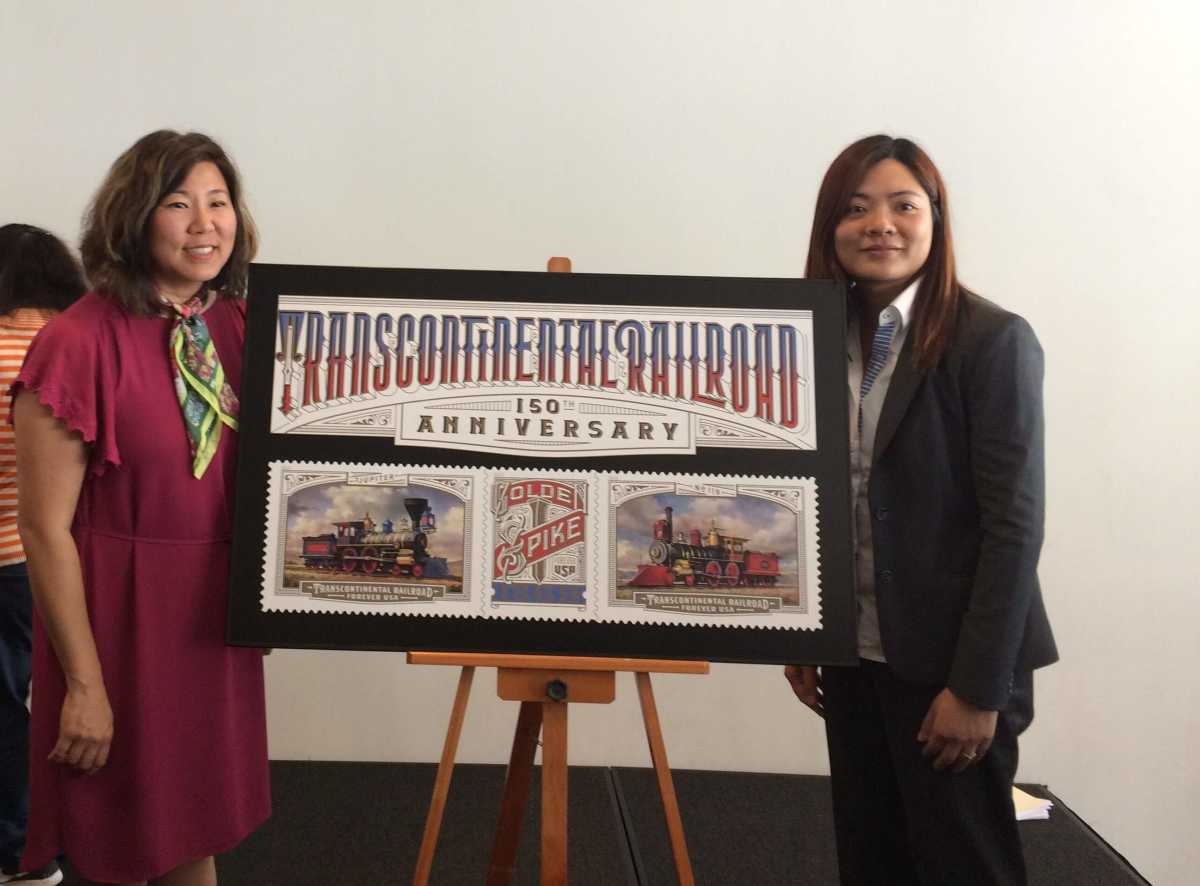Congresswoman Grace Meng joined by officials from the U.S. Postal Service and the Museum of Chinese in America unveiled three new postage stamps on Wednesday that commemorate the 150th anniversary of America’s Transcontinental Railroad.
The event — held at the Museum of Chinese in America at 215 Centre St. in Manhattan — also paid tribute to the many contributions that Chinese immigrant laborers made in constructing the railroad. This month marks the 150th anniversary of the railroad’s completion marked by the “Golden Spike Ceremony” held on May 10, 1869, when rail lines built by the Union Pacific and Central Pacific Railroad companies were joined at Promontory Summit in Utah.
The Transcontinental Forever Railroad stamps were created with distinct designs evoking the spirit of the era. Two separate stamps feature the Jupiter and the No. 119 locomotives that powered the trains carrying the officers and guests of the two train companies to the Golden Spike Ceremony. The third stamp portrays the famous golden spike that was a prominent part of the ceremony.
Meng said she hopes more Americans will become aware of the sacrifices the laborers made, and their contributions to the growth and prosperity of the nation that will never be forgotten.
“The story of the Chinese railroad workers is a story that must be told, and today we are doing exactly that,” said Meng. “Honoring their blood, sweat and labor, and providing them with the recognition they deserve is an outstanding way to mark this milestone anniversary of the railroad. It is crucial that we further weave their story into the greater American tapestry. I thank the Postal Service and the Museum of Chinese in America for joining me in paying tribute to their legacy.”
The Forever stamps will be equal in value to the current First-Class Mail one-ounce price. The stamps can be purchased by the public at Postal Service retail outlets.
“Today and with this stamp, we are finally telling the whole story of the Chinese and Irish railroad workers whose labor and sacrifice created an economic boon for a young nation just recovering from the Civil War,” said Congressman Jerrold Nadler.
From 1865-1869, approximately 12,000 Chinese laborers worked under extremely dangerous and challenging conditions to help construct the railroad, which connected the United States from coast-to-coast. The workers, who endured discrimination, harsh treatment and unequal pay, are credited with playing an integral role in the growth of America and being an important part of U.S. history.
They comprised more than 80 percent of the workforce of the Central Pacific Railroad Company, were tasked with the most difficult and hazardous jobs, and were paid lower wages than other workers. Nearly 1,200 of the workers died from the harsh winters and backbreaking working conditions. The laborers also formed one of the first organized labor movements – and the largest in that era – in the United States calling for better living wages and working conditions.
“My great granduncle Lai Moun (AKA John W. Lee) toiled on the Transcontinental Railroad,” said railroad worker descendant Larry Lee. “He was one of the thousands of Chinese who were nameless and faceless to the outside world. Now, 150 years later, the Chinese railroad workers are finally being remembered as heroes who united and built America.”
Ann Ko of the U.S. Postal Service’s New York District said the labors helped to bind families, frontiers and the economies of two coasts.
“That work developed a stronger, surer future for a young America,” said Ko.
In Congress, Meng has long worked to increase awareness of the Chinese railroad workers and is the sponsor of a resolution that seeks the House of Representatives’ recognition of their contributions and sacrifices. Meng’s measure would also honor those laborers who lost their lives while working in the Sierra Nevada Mountains, and it would acknowledge all the risks they faced while enduring discrimination and unequal pay and treatment.
Earlier this month, the congresswoman helped to open a new display at the Smithsonian’s National Museum of American History that pays tribute to the Chinese railroad workers, and she was a part of the ceremony that inducted the laborers into the U.S. Labor Hall of Honor in 2014.




































